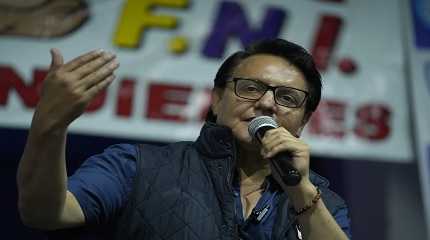
MEXICO CITY (AP) — The brazen assassination of Ecuadorian presidential candidate Fernando Villavicencio at a crowded political rally Wednesday night deepened the country’s sense of vulnerability to the crime that’s spread across the country in recent years.
After multiple threats for his stance against drug trafficking and corruption, Villavicencio was under the watch of police and private security guards. His shooting death has focused global attention on his country’s wave of violent deaths, which began about three years ago, and the connection between organized crime and other powerful interests there.
HOW WAS VILLAVICENCIO THREATENED?
He said during his campaign that he and his team he had been threatened by the Ecuadorian criminal group known as Los Choneros and their leader Alias Fito, whom Villavicencio linked to Mexico’s Sinaloa cartel.
Villavicencio said popular support would protect him,
“You’re my bulletproof vest. I don’t need one. You’re a brave people and I’m as brave as you are,” Villavicencio said at a public meeting in the city of Chone, the heart of Los Choneros territory. “Bring on the drug lords. Bring on the hitmen,” said Villavicencio, wearing only a blue shirt.
His campaign slogan, “Time for the Brave,” referred to his proposal to fight corruption and organized crime by firing large numbers of corrupt security officials if he won, which polls showed as unlikely.
He had already reported threats to his loved ones, and shots were fired at his family home in Quito in September.
WHO’S RESPONSIBLE FOR THE KILLING?
Prosecutors said Wednesday that six people had been arrested in searches in the capital and on Thursday they said that the six are Colombian. One suspect died of wounds sustained in a shootout with police.
Few further details of the investigation have been made public, although Presidente Guillermo Lasso said on the social network X, previously known as Twitter, that he had asked for FBI help investigating, and that FBI agents shortly would be arriving in the country.
WHICH OTHER PUBLIC FIGURES HAVE BEEN KILLED IN ECUADOR?
Villavicencio’s assassination took out the highest public figure eliminated yet in Ecuador’s battle with organized crime. But not the only one.
On July 23, the mayor of Manta, Ecuador’s third largest city, was also shot to death as he toured a crowded neighborhood. Agustín Intriago had been reelected in February and was widely liked for his open hostility to organized crime.
He and seven other mayors lived under police guard, and officials recorded at least 15 attacks on candidates in the last municipal elections, most in the coastal provinces of Manabí and Esmeraldas, where there is a large presence of traffickers moving cocaine by ship out of the country.
Among those killed was Julio César Farachio, 45, a candidate in Salinas, near the port city of Guayaquil, who was shot to death by a hitman during a campaign stop.
ARE ECUADORIAN POLITICS AND ORGANIZED CRIME CONNECTED?
Villavicencio himself had made complaints to prosecutors naming 21 mayoral candidates and other citizens as linked to drug trafficking, and said that he had given authorities information, including financial evidence, that backed up his accusation. He described organized crime, illegal mining and the drug trade as “part of the same criminal structure,” but no criminal case has publicly emerged.
WHEN, AND WHY, DID VIOLENCE RISE IN ECUADOR?
Government authorities say the national wave of violence was triggered by the disappearance of Jorge Zambrano, alias “Rasquiña,” the leader of Los Choneros. His disappearance was followed by a power vacuum and a riot that broke out simultaneously in three prisons in 2021 and left 79 prisoners dead.
Since then, at least a dozen prison riots have killed at least 400 prisoners and moved out onto the streets, where kidnapping, killing and other crimes have terrified the population.
In 2023 so far, Ecuador has seen 3,600 violent deaths. The previous year had 4.600 violent deaths, the country’s highest in history and double the number in 2021. Drug seizures have also risen sharply.
WHAT’S THE LINK TO MEXICAN CARTELS?
Ecuador sits between two of the world’s biggest cocaine producers: Peru and Colombia.
Violence has been attributed to fights for territory between local groups like Los Choneros, Lobos and Tiguerones, which have links to Mexican cartels such as Sinaloa and the Jalisco New Generation, among others.
WHAT GOVERNMENT ACTION IS THERE?
Lasso declared a state of emergency allowing military action in two provinces and prisons nationwide after Villavicencio’s killing, one of at least 19 states of emergency the government has declared over the last two years.
Lasso also wants to increase the number of police and military on the streets and better equip them, although the contracting process has taken longer than expected.




